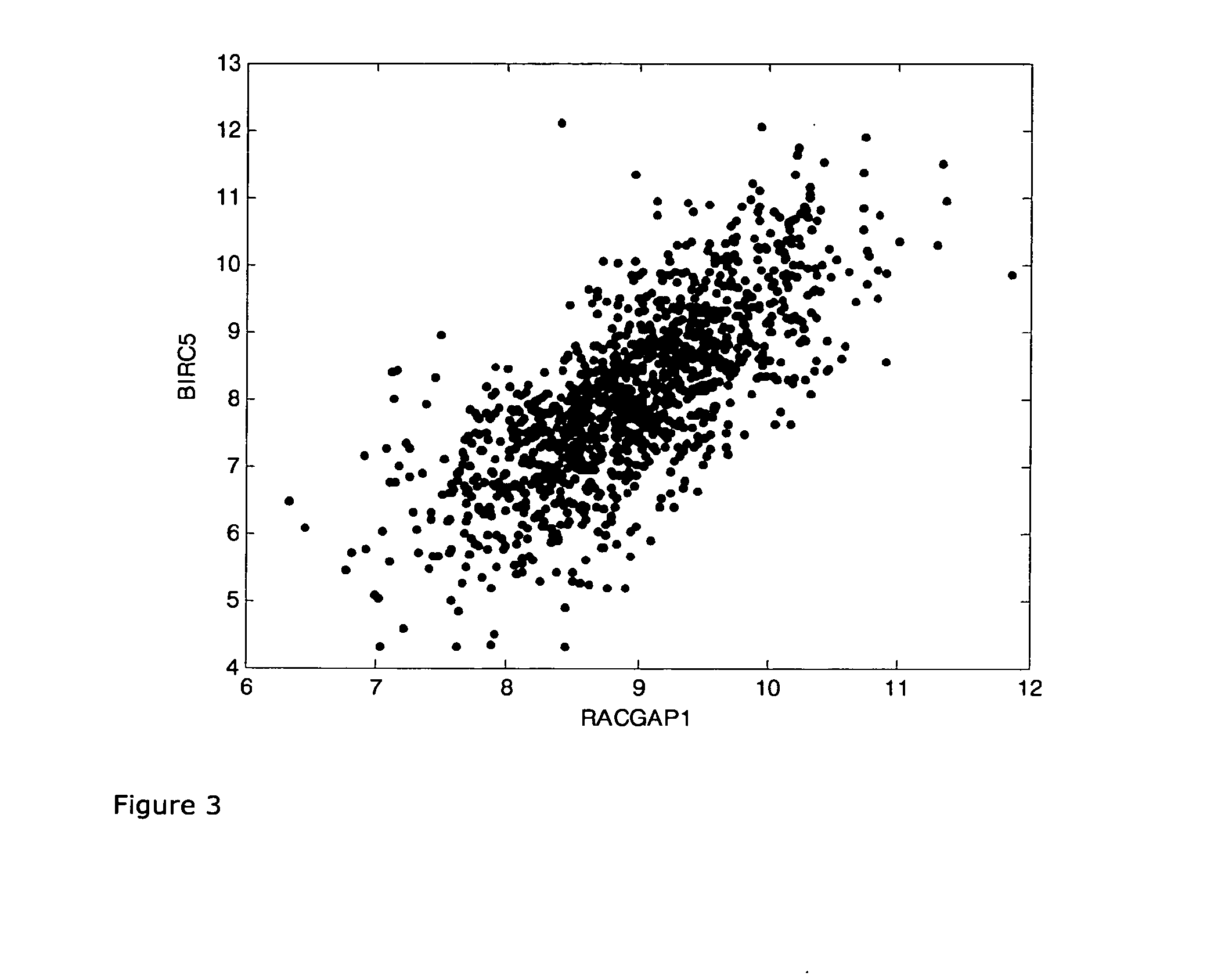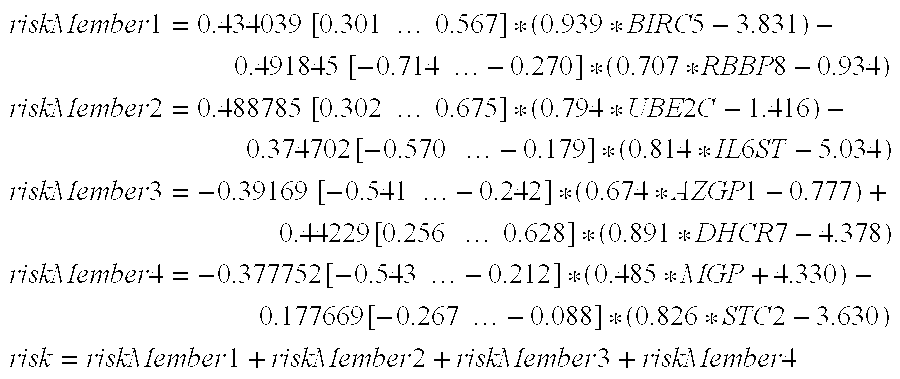Method for predicting the response to chemotherapy in a patient suffering from or at risk of developing recurrentbreast cancer
- Summary
- Abstract
- Description
- Claims
- Application Information
AI Technical Summary
Benefits of technology
Problems solved by technology
Method used
Image
Examples
example algorithm t5
[0096]Algorithm T5 is a committee of four members where each member is a linear combination of two genes. The mathematical formulas for T5 are shown below; the notation is the same as for T1. T5 can be calculated from gene expression data only.
riskMember1=0.434039[0.301…0.567]*(0.939*BIRC5-3.831)-0.491845[-0.714…-0.270]*(0.707*RBBP8-0.934)riskMember2=0.488785[0.302…0.675]*(0.794*UBE2C-1.416)-0.374702[-0.570…-0.179]*(0.814*IL6ST-5.034)riskMember3=-0.39169[-0.541…-0.242]*(0.674*AZGP1-0.777)+0.44229[0.256…0.628]*(0.891*DHCR7-4.378)riskMember4=-0.377752[-0.543…-0.212]*(0.485*MGP+4.330)-0.177669[-0.267…-0.088]*(0.826*STC2-3.630)risk=riskMember1+riskMember2+riskMember3+riskMember4
[0097]Coefficients on the left of each line were calculated as COX proportional hazards regression coefficients, the numbers in squared brackets denote 95% confidence bounds for these coefficients. In other words, instead of multiplying the term (0.939*BIRC5-3.831) with 0.434039, it may be multiplied with any coe...
example algorithm t1
[0100]Algorithm T1 is a committee of three members where each member is a linear combination of up to four variables. In general variables may be gene expressions or clinical variables. In T1 the only non-gene variable is the nodal status coded 0, if patient is lymph-node negative and 1, if patient is lymph-node-positive. The mathematical formulas for T1 are shown below.
riskMember1=+0.193935[0.108 . . . 0.280]*(0.792*PVALB−2.189)−0.240252[−0.400 . . . −0.080]*(0.859*CDH1−2.900)−0.270069[−0.385 . . . −0.155]*(0.821*STC2−3.529)+1.2053[0.534 . . . 1.877]*nodalStatus
riskMember2=−0.25051[−0.437 . . . −0.064]*(0.558*CXCL12+0.324)−0.421992[−0.687 . . . −0.157]*(0.715*RBBP8−1.063)+0.148497[0.029 . . . 0.268]*(1.823*NMU−12.563)+0.293563[0.108 . . . 0.479]*(0.989*BIRC5−4.536)
riskMember3=+0.308391[0.074 . . . 0.543]*(0.812*AURKA−2.656)−0.225358[−0.395 . . . −0.055]*(0.637*PTGER3+0.492)−0.116312[−0.202 . . . −0.031]*(0.724*PIP+0.985)
risk=+riskMember1+riskMember2+riskMember3
[0101]Coefficients on...
PUM
| Property | Measurement | Unit |
|---|---|---|
| Size | aaaaa | aaaaa |
| Level | aaaaa | aaaaa |
| Cytotoxicity | aaaaa | aaaaa |
Abstract
Description
Claims
Application Information
 Login to View More
Login to View More - R&D
- Intellectual Property
- Life Sciences
- Materials
- Tech Scout
- Unparalleled Data Quality
- Higher Quality Content
- 60% Fewer Hallucinations
Browse by: Latest US Patents, China's latest patents, Technical Efficacy Thesaurus, Application Domain, Technology Topic, Popular Technical Reports.
© 2025 PatSnap. All rights reserved.Legal|Privacy policy|Modern Slavery Act Transparency Statement|Sitemap|About US| Contact US: help@patsnap.com



